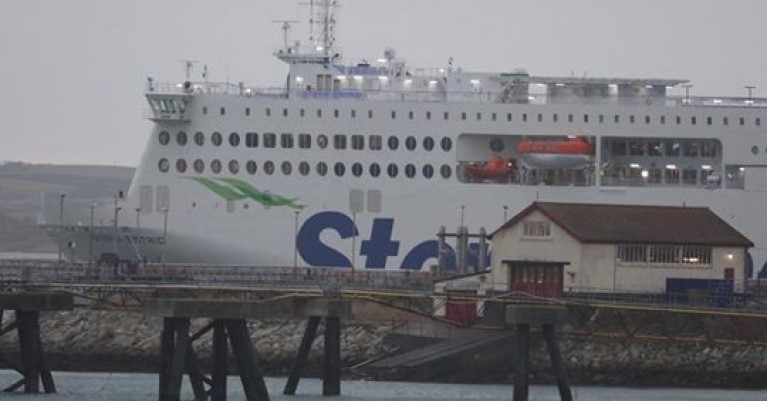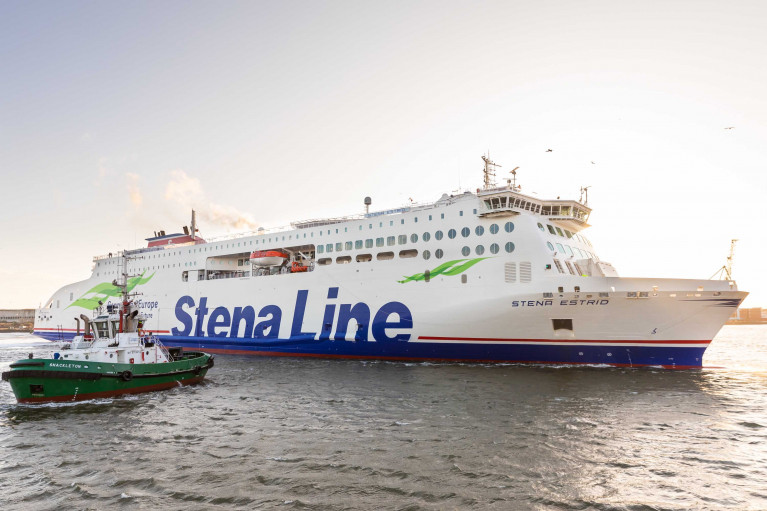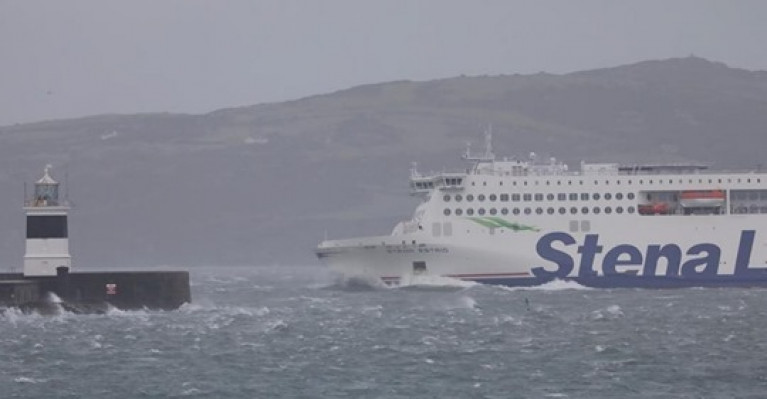Displaying items by tag: Stena Estrid
Ferry operator Stena Line has taken its new £160m super-ferry off service on the Holyhead-Dublin route for repairs and maintenance after suffering engine problems - just four months after entering service.
Stena Estrid started on the route in January after being built at AVIC Weihai Shipyard in China - performing its maiden voyage as Storm Brendan raged.
But now the ship is set to be taken out of service for up to six weeks.
It comes after suffering problems with its German built engines. The ship will be replaced by the Stena Nordica.
This all comes as the ferry industry battles through the coronavirus pandemic with passenger levels vastly reduced.
As NorthWalesLive also reported the ferry is to berth in Cairnryan for work carried out by engineers.
Afloat adds the new leadship of the Stena E-Flexer series ship sailed yesterday from Holyhead and arrived this morning to Cairnryan (Loch Ryan Port) in south-west Scotland.
Ferry Sailing Under Cypriot Flag Stena Say Will Not hit Workers' Rights
Operator Stena Line says it has reassured workers that its decision to sail its new ferry under a Cypriot flag will not hit their rights but a Welsh Assembly Member (AM) fears "serious implications" after contacting tax chiefs.
The £160m Stena Estrid went into service on the Holyhead to Dublin route last month.
During its sail from the Chinese shipyard where it was built to North Wales the ship's registration was changed - due to Brexit - so that on paper it sails under the flag of Cyprus.
Fears were raised last month about how this could affect the rights of mariners working on the vessel but Stena did not respond at the time.
Now tax chiefs and Stena have written to Ynys Mon AM Rhun ap Iorwerth in letters seen by North Wales Live which has much more on the story.
Not even Storm Brendan as Afloat reported, could prevent Stena Line’s newest ferry Stena Estrid making its maiden voyage yesterday on the Holyhead to Dublin route.
After more than six years’ in planning and construction, Estrid braved the challenging sea conditions created by Storm Brendan to set sail from the Port of Holyhead at 10.55am, arriving in Dublin Port shortly after 2.30pm where it received a traditional maritime water cannon salute.
Described as one of the most modern ferries in the world, Estrid set sail again from Dublin Port at around 5.30pm to complete the first-round trip of the ferry's new Irish Sea home.
Stena Estrid will make two daily return trips on the route, with scheduled departures as below:
|
Ex-Holyhead |
Ex-Dublin |
|
08:55hrs |
14:50hrs |
|
20:30hrs |
02:15hrs |
A crossing time of three hours and 15 minutes is barely enough time for passengers to check out the range of facilities on board, including Estrid’s Sky Bar, two Happy World children’s play areas, a relaxing Hygge reclining lounge, Stena Plus lounge, two movie lounges, a larger Truckers lounge, the Taste restaurant in addition to a bigger better shopping experience.
Ian Davies, Stena Line’s Trade Director (Irish Sea South), speaking yesterday said: “Today is a very significant day, not just for Stena Line but for the future of ferry travel on the Irish Sea, as we welcome Stena Estrid to her new home on the Irish Sea. Despite the best efforts of Storm Brendan Stena Estrid was able to fulfil her maiden voyage commitment albeit slightly delayed due to severe weather conditions on the Irish Sea.
“The introduction of Stena Estrid on the Holyhead to Dublin route is the result of a very significant investment that reflects our commitment to this extremely important region – a commitment that will ultimately see three of the world’s most modern ferries operating between Ireland and Britain.
“I’m proud that Stena Line continues to shape the industry for the 'next-generation' of freight and travel customers, for whom we are determined to deliver the best possible service. Stena Estrid will enable us to do this with more efficient loading and unloading operations, increased freight capacity and the best Scandinavian quality, style and design in our facilities -in an onboard environment that is spacious and light, with amazing panoramic views,” he added.
“The Captain and crew have all been wowed by the new ship and we are sure that all of our customers travelling between Dublin and Holyhead will be similarly impressed,” concluded Mr Davies.
Stena Estrid is the first of three new ferries that will operate on the Irish Sea as part of a multi-million-pound investment by Stena Line in the region. Sister ship Stena Edda is expected to commence operations from Liverpool to Belfast this spring, with a third vessel Stena Embla to be introduced on the same route in early 2021.
At 215 metres in length, Stena Estrid is one of the most advanced vessels in operation and larger than today’s standard RoPax vessels, with space to carry 120 cars and 1,000 passengers, and a freight capacity of 3,100 lane meters, meaning a 50 per cent increase in freight tonnage.
The newest Stena Line ferry is expected to begin sailing the Dublin to Holyhead route on the Irish Sea today.
The 215m (705ft) Stena Estrid, writes Independent.ie, is described as "one of the most advanced vessels in operation", with space to carry 120 cars and 1,000 passengers.
The ship's official maiden voyage, a 8.55am sailing from Holyhead to Dublin, has been delayed due to adverse weather coinciding with Storm Brendan, but a 2.50pm departure from Dublin remains on schedule as we publish.
For more click the newspaper here in addition to Welsh coverage from the NorthWalesLive.
In an update, Afloat adds that the corresponding sailing from the Irish capital has been delayed this afternoon. According to the Stena Line website, the 'new generation' ropax ferry has been delayed approximately by an hour due adverse weather conditions.
Newest Ferry For Irish Sea Stena Service On Delivery Voyage from Shipyard in China to Wales
The newest ferry bound for Irish Sea service, Stena Estrid has departed the AVIC Weihai Shipyard in north-western China and is making its delivery voyage to Wales from where it is to operate on the Holyhead-Dublin route.
Stena Estrid is the first of five next generation Stena Line 'E-Flexer' RoPax vessels to be completed in the Asian shipyard and from where Afloat adds the newbuild departed a week ago.
According to the ferry company, Stena Estrid is manned by a much-reduced crew of 27, with no passengers on board the voyage which will travel well over 10,000 miles, taking just over one month and making a number of stops on the way.
The first stage of the voyage is a week-long 2,657 nautical miles trip across the South China and then East China Sea to Singapore (Afloat adds, where today the ship is anchored offshore) having travelling at an economical speed of 17 knots. This is unique to Estrid and sister ships, where they can achieve by running on just one of its 12,600kW main engines, thus minimising fuel consumption.
Having refuelled and stocked up on fresh provisions, Estrid will then proceed at a speed of 15 knots through the Malacca Straits to Galle in Sri Lanka, before crossing the Indian Ocean and making its way to the Suez Canal.
Once through the Suez Canal, the ship will head west across the Mediterranean Sea, continuing at 15 knots until it reaches Gibraltar where it will stop for more fuel and provisions. In addition and most importantly from there it will welcome onboard more crew members who will undertake familiarisation and training during the final leg of Stena Estrid’s journey. This will involve a passage through the Atlantic Ocean, across the Bay of Biscay and finally to the Welsh port of Holyhead, where, all being well, it is expected to arrive just before or after Christmas.
Once in Holyhead, final preparations will begin to get Estrid ready to start service on the route in mid-January.
Speaking from the ship’s bridge, shortly after departure, Senior Master Matthew Lynch said: “After six years of planning and construction, we are so excited to be finally on board Stena Estrid and departing China on our way home to Britain.
“At this precise moment, we’ve only travelled approximately 70 miles but it was an interesting start to our journey as we passed a fleet of over 100 Chinese fishing vessels! We obviously have a very long way to go but we’re really looking forward to it and to meeting with our colleagues in Gibraltar, before embarking the final leg of our journey to Holyhead,” he added.
At 215 metres in length, Stena Estrid will provide freight capacity of 3,100 lane meters, meaning a 50 per cent increase in freight tonnage, and the space to carry 120 cars and 1,000 passengers and crew.
A further two of the new ferries are also destined for the Irish Sea with Stena Edda and Stena Embla. Afloat adds in the above photo includes Brittany Ferries chartered E-Flexer tonnage for UK-Spain service is seen in the background berthed on the left.
Stena Edda is expected to enter Belfast-Birkenhead (Liverpool) service next spring, leaving the third sister, Stena Embla to be introduced on the same route in early 2021. The introduction of the pair will increase freight capacity on this Irish Sea route by 20 per cent.

































































